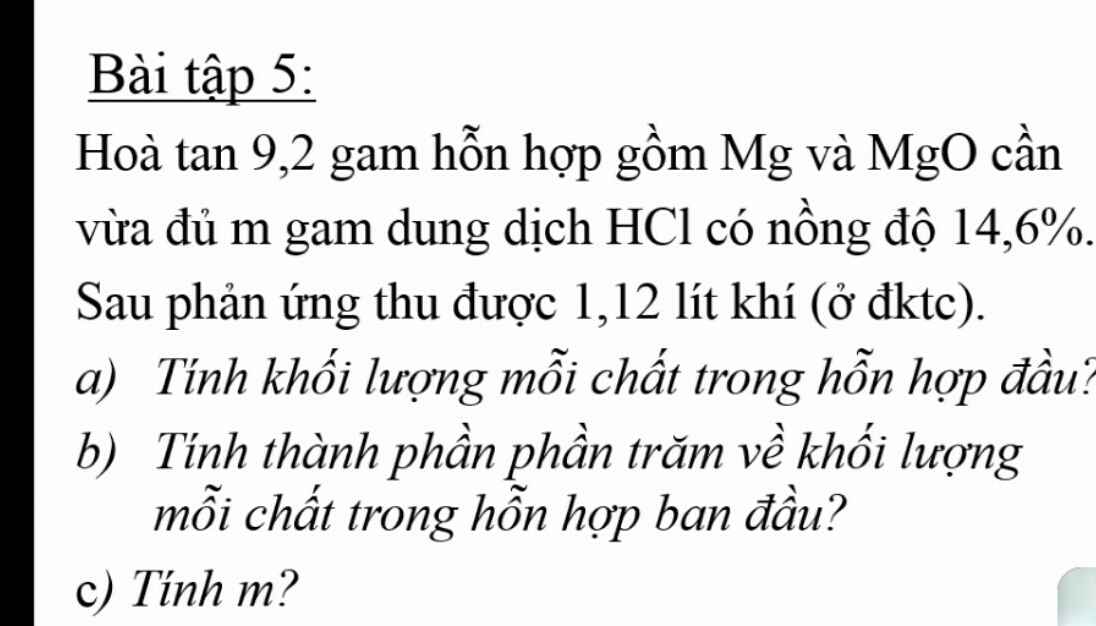
Mọi người trình bày chi tiết giúp e nha, chứ e ngu mấy cái này lắm. Cảm ơn mọi người
Giúp em với please 😭 (mấy bài này e ko hiểu lắm mong mọi người giải dễ hiểu,chi tiết giúp e với)
- Gọi quãng đường AB là x (km)
vì thời gian là bằng quãng đường chia vận tốc, ta có:
- Thời gian của ô tô là \(\dfrac{x}{50}\) (km)
- Thời gian của xe máy là \(\dfrac{x}{40}\) (km)
vì ta dùng đơn vị là km/h nên ta phải đổi 30 phút qua giờ, ta có:
- Đổi: 30 phút = 0,5 giờ
vì thời gian đi của ô tô ít hơn xe máy là 0,5 giờ nên ta có phương trình:
\(\dfrac{x}{40}\) \(-\) \(\dfrac{x}{50}\) = 0,5
\(\Leftrightarrow\) \(\dfrac{x\times50}{40\times50}\)\(-\)\(\dfrac{x\times40}{50\times40}\) = \(\dfrac{0,5\times40\times50}{40\times50}\)
\(\Leftrightarrow\) \(\dfrac{50x}{40\times50}\)\(-\dfrac{40x}{50\times40}=\dfrac{1000}{50\times40}\)
\(\Rightarrow\) 50x - 40x = 1000
\(\Leftrightarrow\)10x = 1000
\(\Leftrightarrow\) x = 1000 : 10
\(\Leftrightarrow\) x = 100
vậy quãng đường AB là 100 (km)
----chúc cậu học tốt----
Đổi \(30phút=\dfrac{1}{2}h\)
Gọi quãng đường AB là \(x\left(km;x>0\right)\)
Thì thời gian ô tô đi từ A đến B là \(\dfrac{x}{50}\left(h\right)\)
Thời gian xe máy đi từ A đến B là \(\dfrac{x}{40}\left(h\right)\)
Vì thời gian đi từ A đến B của ô tô ít hơn của xe máy là \(\dfrac{1}{2}h\) nên ta có phương trình :
\(\dfrac{x}{40}-\dfrac{x}{50}=\dfrac{1}{2}\)
\(\Leftrightarrow5x-4x=100\)
\(\Leftrightarrow x=100\left(nhận\right)\)
Vậy quãng đường AB dài \(100km\)
Làm phép chia (mọi người giải chi tiết từng ý 1 giúp e nha)
Bài 1: làm phép chia ( mọi người giải chi tiết giúp e nha)
a: (2x⁴ + x³ - 5x² - 3x - 3) : (x² - 3)
b: (2x³ + 5x² - 2x + 3) : (2x² - x + 1)
c: (x⁴ - x - 14) : (x-2)
d: (17x² - 6x⁴ + 5x³ - 23x + 7) : (7 - 3x² - 2x)
Mọi người cố gắng giải giúp e trước 2h20 nha e cần gấp lắn ạ. E cảm ơn mọi người
Mọi người giúp em trình bày chi tiết (nếu được). Em cảm ơn ạ

Mọi người giúp em đề này với ạ. E cảm ơn mọi người nhiều lắm
Bài 1: làm phép chia (mọi người gải chi tiết giúp e nha) mọi người ơi e cần gấp lắm mọi người giúp e với
a: (4x² - 9y²): (2x - 3y)
b: (27x³ - 1) : (3x² - 1)
c: (8x³ + 1) : (4x² - 2x + 1)
d: (x² - 3x +xy - 3y): (x + y)
e: (6x³ - 7x² - x + 2): (2x + 1)
f: (x⁴ - x³ + x² + 3x) : (x² - 2x + 3)
Mọi người làm đc con nào thì gửi câu hỏi cho e nha. Còn câu nào ko là đc thì thôi ạ. E cảm ơn mọi người
Tìm x biết (mọi người giải chi tiết giúp e nha )
a: 2 (x + 5) - x^2 - 5x =0
b: x^3 - 6x^2 + 12x - 8 =0
c: 16x^2 - 9 (x + 1)^2 =0
d: x^3 + x =0
e: x^2 - 2x - 3 =0
Mọi người giải giúp e trước 1h30 đc khong ạ e cần gấp lắm ạ. E cảm ơn mọi người nhiều
a) \(2\left(x+5\right)-x^2-5x=0\)
\(\Leftrightarrow2x+10-x^2-5x=0\)
\(\Leftrightarrow-x^2-3x+10=0\)
\(\Leftrightarrow x^2+3x-10=0\)
\(\Leftrightarrow x^2-2x+5x-10=0\)
\(\Leftrightarrow x\left(x-2\right)+5\left(x-2\right)=0\)
\(\Leftrightarrow\left(x-2\right)\left(x+5\right)=0\)
\(\Leftrightarrow\orbr{\begin{cases}x-2=0\\x+5=0\end{cases}\Leftrightarrow\orbr{\begin{cases}x=2\\x=-5\end{cases}}}\)
b) \(x^3-6x^2+12x-8=0\)
\(\Leftrightarrow\left(x^3-8\right)-\left(6x^2-12x\right)=0\)
\(\Leftrightarrow\left(x-2\right)\left(x^2+2x+4\right)-6x\left(x-2\right)=0\)
\(\Leftrightarrow\left(x-2\right)\left(x^2+2x+4-6x\right)=0\)
\(\Leftrightarrow\left(x-2\right)\left(x^2-4x+4\right)=0\)
\(\Leftrightarrow\left(x-2\right)\left(x-2\right)^2=0\)
\(\Leftrightarrow\left(x-2\right)^3=0\)
\(\Leftrightarrow x-2=0\Leftrightarrow x=2\)
c)\(16x^2-9\left(x+1\right)^2=0\)
\(\Leftrightarrow\left(4x\right)^2-\left[3\left(x+1\right)\right]^2=0\)
\(\Leftrightarrow\left(4x-3x-1\right)\left(4x+3x+1\right)=0\)
\(\Leftrightarrow\left(x-1\right)\left(7x+1\right)=0\)
\(\Leftrightarrow\orbr{\begin{cases}x-1=0\\7x+1=0\end{cases}\Leftrightarrow\orbr{\begin{cases}x=1\\x=-\frac{1}{7}\end{cases}}}\)
d) \(x^3+x=0\)
\(\Leftrightarrow x^2\left(x+1\right)=0\)
\(\Leftrightarrow\orbr{\begin{cases}x^2=0\\x+1=0\end{cases}\Leftrightarrow\orbr{\begin{cases}x=0\\x=-1\end{cases}}}\)
e)\(x^2-2x-3=0\)
\(\Leftrightarrow x^2+x-3x-3=0\)
\(\Leftrightarrow x\left(x+1\right)-3\left(x+1\right)=0\)
\(\Leftrightarrow\left(x+1\right)\left(x-3\right)=0\)
\(\Leftrightarrow\orbr{\begin{cases}x+1=0\\x-3=0\end{cases}\Leftrightarrow\orbr{\begin{cases}x=-1\\x=3\end{cases}}}\)
Tính giá trị cảu biểu thức ( mọi người giải chi tiết giúp e nha )
A= 2x^2 + 4x + xy +2y tại x=88; y=-76
B= x^2 + xy - 7x - 7y tại x=7 \(\frac{3}{5}\); y=2\(\frac{2}{5}\)
Mọi người giải giúp e trước 2h15p đc không ạ giải đc cành nhanh càng tốt ạ e cảm ơn mọi người. Thực sự e cần gấp lắm ạ
cái này mk làm ở câu dưới của bạn r` đó -_-" nèCâu hỏi của Phạm Hoa - Toán lớp 8 - Học toán với OnlineMath
a, =(x+2)*(y+2*x)
= (88+2)(y+2.-76)
= 90*y-6660
b, = (x-7)*(y+x)
\(\left(7\frac{3}{5}-7\right)\left(2\frac{2}{5}+7\frac{3}{5}\right)\)
= 3/5 . 10
=6
k cho tớ nha :))))))
Mọi người ơi giúp em gấp với gấp lắm sáng mai em nộp,giải chi tiết giúp em nha!em cảm ơn nhiều

Bài 2:
\(a,n_{H_2}=\dfrac{1,12}{22,4}=0,05(mol)\\ PTHH:Mg+2HCl\to MgCl_2+H_2\\ MgO+2HCl\to MgCl_2+H_2O\\ \Rightarrow n_{Mg}=0,05(mol)\\ \Rightarrow m_{Mg}=24.0,05=1,2(g)\\ \Rightarrow m_{MgO}=9,2-1,2=8(g) b,\%_{Mg}=\dfrac{1,2}{9,2}.100\%=13,04\%\\ \Rightarrow \%_{MgO}=100\%-13,04\%=86,96\%\\ c,n_{MgO}=\dfrac{8}{40}=0,2(mol)\\ \Rightarrow \Sigma n_{HCl}=2n_{Mg}+2n_{MgO}=0,5(mol)\\ \Rightarrow \Sigma m_{HCl}=0,5.36,5=18,25(g)\\ \Rightarrow m_{dd_{HCl}}=\dfrac{18,25}{14,6\%}=125(g)\)
Bài 5 :
\(n_{H2}=\dfrac{1,12}{22,4}=0,05\left(mol\right)\)
Pt : \(Mg+2HCl\rightarrow MgCl_2+H_2|\)
1 2 1 1
0,05 0,1 0,05
\(MgO+2HCl\rightarrow MgCl_2+H_2O|\)
1 2 1 1
0,2 0,4
a) \(n_{Mg}=\dfrac{0,05.1}{1}=0,05\left(mol\right)\)
\(m_{Mg}=0,05.24=1,2\left(g\right)\)
\(m_{MgO}=9,2-1,2=8\left(g\right)\)
b) 0/0Mg = \(\dfrac{1,2.100}{9,2}=13,04\)0/0
0/0MgO = \(\dfrac{8.100}{9,2}=86,96\)0/0
c) Có : \(m_{MgO}=8\left(g\right)\)
\(n_{MgO}=\dfrac{8}{40}=0,2\left(mol\right)\)
\(n_{HCl\left(tổng\right)}=0,1+0,4=0,5\left(mol\right)\)
\(m_{HCl}=0,5.36,5=18,25\left(g\right)\)
\(m_{ddHCl}=\dfrac{18,25.100}{14,6}=125\left(g\right)\)
Chúc bạn học tốt
Bài 3:
\(a,PTHH:Na_2CO_3+2HCl\to 2NaCl+H_2O+CO_2\uparrow\\ b,n_{Na_2CO_3}=\dfrac{21,2}{106}=0,2(mol)\\ \Rightarrow n_{CO_2}=0,2(mol)\\ \Rightarrow V_{CO_2}=0,2.22,4=4,48(l)\\ c,m_{dd_{HCl}}=1,15.300=345(g)\\ n_{NaCl}=0,4(mol);n_{H_2O}=n_{CO_2}=0,2(mol)\\ \Rightarrow m_{NaCl}=0,4.58,5=23,4(g)\\ m_{H_2O}=18.0,2=3,6(g)\\ m_{CO_2}=44.0,2=8,8(g)\\ m_{dd_{NaCl}}=21,2+345-3,6-8,8=353,8(g)\\ \Rightarrow C\%_{NaCl}=\dfrac{23,4}{353,8}.100\%=6,61\%\)
Mọi người giúp em bài này với ạ, mn giải chi tiết giúp em nha, cảm ơn mn
